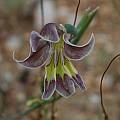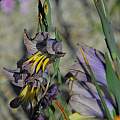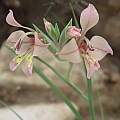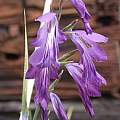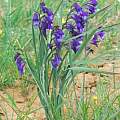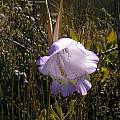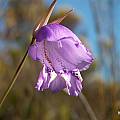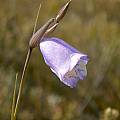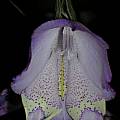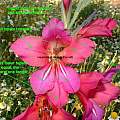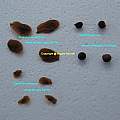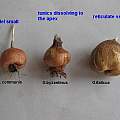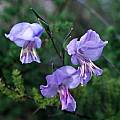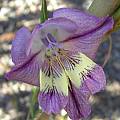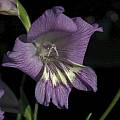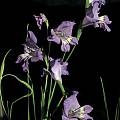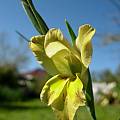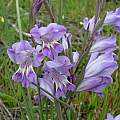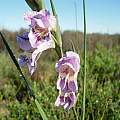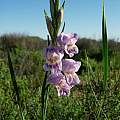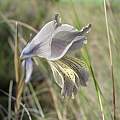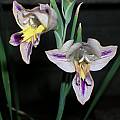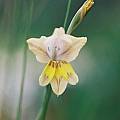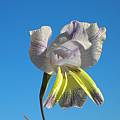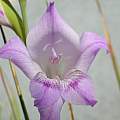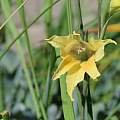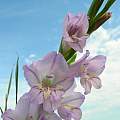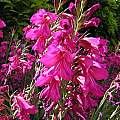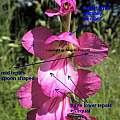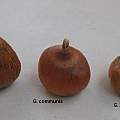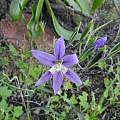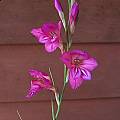Magenta to dark bluish purple is a another focus of Gladiolus diversity. Most of the Eurasian forms can be found here, but there are many South Africans as well.
Page 2: G. imbricatus... Page 3: G. mutabilis... Page 4: G. scullyi...
Gladiolus arcuatus Klatt grows in the dry western part of the winter rainfall area of South Africa. In Namaqualand this species grows among low shrubs in granite derived gravel and in fine grained silt in areas to the south. It has flowers that are dull grey purple, brownish or dark purple, with the lower three tepals yellow in the lower two thirds with the distal third dark purple fading to light grey purple. The dorsal tepal is largest, horizontal and arching forward. Flowers are very fragrant and probably pollinated by long tongued bees. Height: 12-20 cm high. The first photo below could be this species. It was seen in early September 2006 in Namaqualand in the right habitat. The second photo taken earlier that year was taken at Rod and Rachel Saunders' property at Brackenfell. They often sprinkle seed about. I think it also could be this species. Photos 1-2 taken by Mary Sue Ittner. Photo #3 taken by Rod Saunders.
Gladiolus atroviolaceus is native to Greece, Turkey, Iraq and Iran and has deep violet-purple flowers and blooms spring to summer. Height: to 60 cm. First photo by Jane McGary of a plant grown from seed purchased from Jim and Jenny Archibald as Gladiolus antakiensis but not that species. Second photo was taken in its habitat South of Madaba in Jordan by Oron Peri.
Gladiolus bullatus Thunb. ex G.J.Lewis is found on sandstone slopes in fynbos in the southwest Cape and the Agulhas plain. This species is reported to be difficult in cultivation. It has bell-like blue flowers with yellow markings and is hooded. Height: 50-80 cm. The first photo by Bob Rutemoeller was taken at Boskloof, the second and third by Cameron McMaster in the Overberg, and the last a close-up from Alan Horstmann.
Gladiolus byzantinus is considered to be a synonym of Gladiolus communis by The Plant List and the Kew checklist. Angelo Porcelli makes a case for it to be considered a species in its own right in his paper Gladiolus of Southern Italy. In this paper he describes the differences between it and Gladiolus communis and Gladiolus italicus. This paper also shows the difference between the seeds and the corms. This species grows up to 40 inches (100 cm). The central tepal of the three lower tepals is visibly longer and even wider than Gladiolus communis. The upper central tepal points up and the mid tepals are rhomboid shaped. It is usually a dark rich purple. Gladiolus byzantinus has large winged seeds of about 1 cm. The corm tunics dissolve (separate) at the apex with parallel and much wider veins. Photos by Angelo Porcelli.
Gladiolus carinatus Aiton is found on sandstone slopes or deep coastal sands in many areas of the Cape. It flowers late winter to spring and can be blue to violet or yellow, rarely pink, often with yellow markings on the lower tepals. Height range: 30-60 cm high. The first two photos were taken by Mary Sue Ittner; the first photo was taken September 2001 in the Southwest Cape and the second shows the flower of a plant grown from seed and flowering March 2004. The next two were taken by Bob Werra. The last photo from Cameron McMaster shows a yellow form grown from seed by Rhoda McMaster.
The first five photos were taken in the Western Cape in Hopefield, Elands Bay, and near Napier by Cameron McMaster. The last photo is from Rod Saunders.
The photos from Alan Horstmann show different forms.
Gladiolus communis is listed on The Plant List with 23 synonyms. It is distributed from the Mediterranean to Caucasus. The species names byzantinus and communis are often given as synonyms and you often see Gladiolus byzantinus ssp. communis, Gladiolus communis ssp. byzantinus, and Gladiolus communis var. byzantinus. It is deep purple-red with narrow, paler marks outlined in dark purple on the lower lobes. In Angelo Porcelli's paper Gladiolus of Southern Italy he explains the difference between this species, Gladiolus byzantinus and Gladiolus italicus. This species grows up to 40 inches (100 cm). The three lower tepals are more or less the same length and width. The upper central tepal is hooded. G. communis often has a slight two-tone effect on the lower tepals, but this is not a reliable feature, as many individuals are a solid color. The median tepals have a "spoon" shape. The seeds are winged, 3 to 5 mm and corm tunics have very close parallel veins. The plants in the first photo below from Bob Rutemoeller were blooming at Kew Gardens in May 2004 under the label Gladiolus communis subsp. byzantinus. The next two photos were taken from the article by Angelo Porcelli mentioned above.
Gladiolus deserticola Goldblatt is restricted to the Richtersveld, a mountainous area of northern Namaqualand. Plants grow in sheltered sites, most frequently in clay soils on south-facing slopes protected by rock or shrubs. Flowers are dark blue with a darker line in the midline of the tepals. The lower tepals or the lateral lower tepals are cream edged with purple. Flowers are weakly rose scented. Height: 10-20 cm. Photo from Rachel Saunders who found a single specimen blooming in July 2011, a bit early for this species that usually blooms mid August to mid September.
Gladiolus illyricus is native to south and west Europe and the Mediterranean region, growing on heaths, in scrub and open woods. It flowers April to August and is similar to G. communis with flowers facing in two directions but is usually shorter with 3 to 10 flowers on a rarely branched stem. Flowers are magenta purple with white markings on the lower 3 lobes. Photos taken by Mary Sue Ittner of plants grown from seed labeled this and hopefully are correctly identified.
Page 2: G. imbricatus... Page 3: G. mutabilis... Page 4: G. scullyi...
